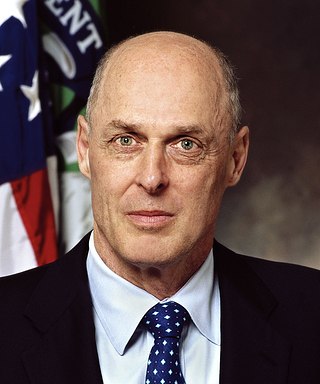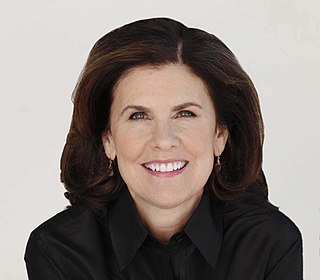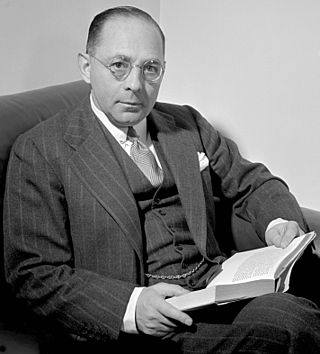
The Goldman Sachs Group,Inc. is an American multinational investment bank and financial services company. Founded in 1869,Goldman Sachs is headquartered in Lower Manhattan in New York City,with regional headquarters in London,Warsaw,Bangalore,Hong Kong,Tokyo,Dallas and Salt Lake City,and additional offices in other international financial centers. Goldman Sachs is the second largest investment bank in the world by revenue and is ranked 55th on the Fortune 500 list of the largest United States corporations by total revenue. It is considered a systemically important financial institution by the Financial Stability Board.
James A. Johnson was an American businessman,Democratic Party political figure,and chairman and chief executive officer of Fannie Mae. He was the campaign chairman for Walter Mondale's unsuccessful 1984 presidential bid and chaired the vice presidential selection committee for the presidential campaign of John Kerry. He briefly led the vice-presidential selection process for the 2008 Democratic presidential nominee,Senator Barack Obama.

Joshua Brewster Bolten is an American lawyer and politician. Bolten served as the White House chief of staff to U.S. president George W. Bush,replacing Andrew Card on April 14,2006. Previously,he served as the director of the Office of Management and Budget from 2003 to 2006.

Robert Edward Rubin is an American retired banking executive,lawyer,and former government official. He served as the 70th United States Secretary of the Treasury during the Clinton administration. Before his government service,he spent 26 years at Goldman Sachs,eventually serving as a member of the board and co-chairman from 1990 to 1992.

Stephen Friedman is the former chairman of the US President's Intelligence Advisory Board. He was nominated on October 27,2005,to replace Brent Scowcroft in the position.

Richard L. "Jake" Siewert Jr. is an American political advisor serving as the head of corporate communications for investment bank Goldman Sachs. He served as the 22nd White House Press Secretary and the last of the Clinton administration and later in the Treasury department during the Obama Administration.

Henry "Hank" Merritt Paulson Jr. is an American banker and financier who served as the 74th United States Secretary of the Treasury from 2006 to 2009. Prior to his role in the Department of the Treasury,Paulson was the Chairman and Chief Executive Officer (CEO) of major investment bank Goldman Sachs.

Gary David Cohn is an American businessman and philanthropist who served as the 11th Director of the National Economic Council and chief economic advisor to President Donald Trump from 2017 to 2018. He managed the administration's economic policy agenda. Before serving in the White House,Cohn was president and COO of Goldman Sachs,where he worked for more than 25 years. Cohn was appointed vice-chairman of IBM on January 5,2021.
G. Kennedy Thompson, also known as Ken Thompson, is an American banker and businessman who was chairman,president,and CEO of Wachovia Corporation,formerly First Union Corporation,from 2000 through 2008. During his leadership,Wachovia grew to become the nation's fourth largest bank.

Lloyd Craig Blankfein is an American investment banker who has served as senior chairman of Goldman Sachs since 2019,and chairman and chief executive from 2006 until the end of 2018. Previous to leading Goldman Sachs,he was the company's president and chief operating officer (COO) from 2004 to 2006,serving under then-CEO Henry Paulson.
Alan David Schwartz is an American businessman and is the executive chairman of Guggenheim Partners,an investment banking firm based in Chicago and New York City. He was previously the last president and chief executive officer of Bear Stearns when the Federal Reserve Bank of New York forced its March 2008 acquisition by JPMorgan Chase &Co.

Peter Amory Weinberg is an American businessman. He spent almost twenty years of his career at Goldman Sachs before co-founding Perella Weinberg Partners with merger specialist,Joseph Perella in 2006. The firm provides M&A advisory and alternative asset management services. Weinberg serves as its Chief Executive Officer and Founding Partner.
This article outlines the history of Wells Fargo &Company from its merger with Norwest Corporation and beyond. The new company chose to retain the name of "Wells Fargo" and so this article is about the history after the merger.

Suzanne Nora Johnson is an American corporate lawyer and executive. Until 2007,she was vice chairman of Goldman Sachs,chair of the Global Markets Institute,head of the firm's Global Investment Research Division,and a member of the firm's management committee.

Sidney James Weinberg was a long-time leader of the Wall Street firm Goldman Sachs,nicknamed “Mr. Wall Street” by The New York Times and "director's director" by Fortune magazine. In a rags-to-riches story,he rose from a janitor's assistant,making $3/week,to CEO.

Wachovia was a diversified financial services company based in Charlotte,North Carolina. Before its acquisition by Wells Fargo and Company in 2008,Wachovia was the fourth-largest bank holding company in the United States,based on total assets. Wachovia provided a broad range of banking,asset management,wealth management,and corporate and investment banking products and services. At its height,it was one of the largest providers of financial services in the United States,operating financial centers in 21 states and Washington,D.C.,with locations from Connecticut to Florida and west to California. Wachovia provided global services through more than 40 offices around the world.

Terence James O'Neill,Baron O'Neill of Gatley is a British economist best known for coining BRIC,the acronym that stands for Brazil,Russia,India,and China—the four once rapidly developing countries that were thought to challenge the global economic power of the developed G7 economies. He is also a former chairman of Goldman Sachs Asset Management and former Conservative government minister. As of January 2014,he is an Honorary Professor of Economics at the University of Manchester.

Robert David "Bob" Hormats is Vice Chairman of Kissinger Associates. Immediately prior he served as Under Secretary of State for Economic Growth,Energy,and the Environment from 2009 to 2013. Hormats was formerly Vice Chairman of Goldman Sachs (International),which he joined in 1982. He served as Senior Deputy Assistant Secretary,from 1977 to 1979,and Assistant Secretary of State,from 1981 to 1982,at the Bureau of Economic and Business Affairs. He was Ambassador and Deputy U.S. Trade Representative from 1979 to 1981. He served as a senior staff member for International Economic Affairs on the United States National Security Council from 1969 to 1977,where he was senior economic adviser to Henry Kissinger,General Brent Scowcroft and Zbigniew Brzezinski. He helped to manage the Nixon administration's opening of diplomatic relations with China's communist government. He was a recipient of the French Legion of Honor in 1982 and the Arthur S. Flemming Award in 1974.














